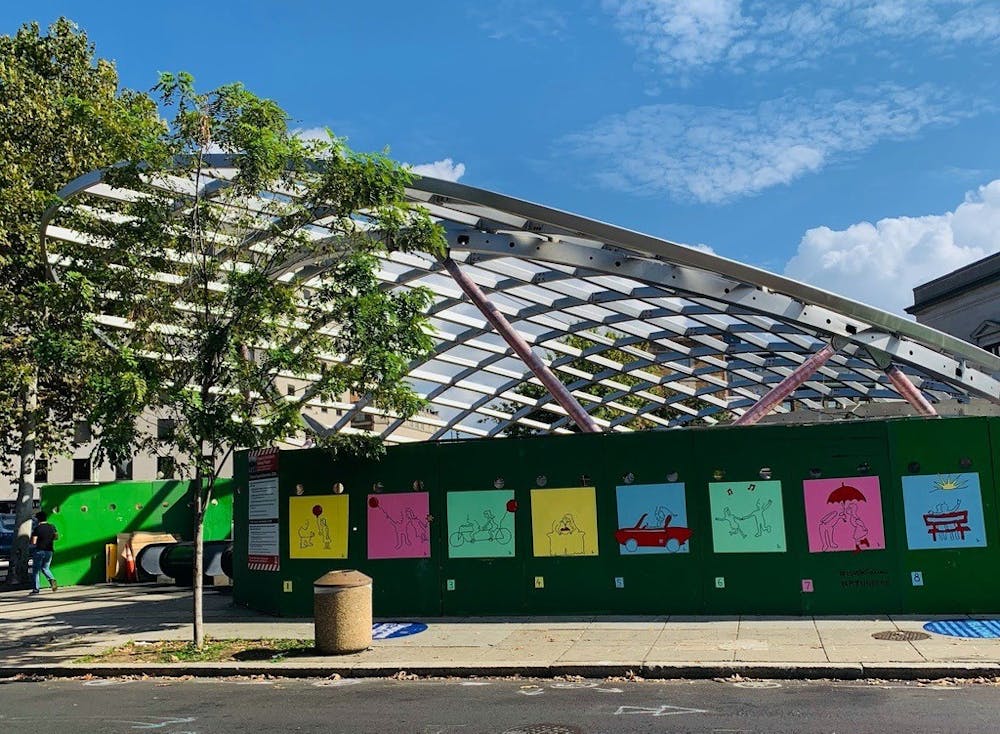Even though the exhibit is only temporary, two local artists decorated the construction barricades at the Dupont Circle Metro station to beautify the neighborhood.
Construction is underway for a new overhead canopy to protect riders entering and exiting the escalator from harsh weather at the north entrance of the Dupont Circle Metro station. Temporary construction barricades surround the project to shield messy construction work from public view and to protect pedestrians from any debris or potential worksite accidents.
Local artists Timoteo Murphy and Ravi Raman worked in partnership with the Dupont Circle Business Improvement District and the Washington Metropolitan Area Transit Authority Art in Transit program to paint the temporary barricades.
“WMATA is aware that the construction canopy may not be the most visually appealing thing to look at every day,” said Laurent Odde, the program manager for the WMATA Art in Transit program.
To remedy this eyesore, Murphy and Raman covered the bright green barricades with their artwork.
“This project is ephemeral,” said Anne Delaney, the project coordinator for the WMATA Art in Transit program. “It’s on a temporary structure. I think there is an appeal that people will enjoy it, remember it, miss it. It’s a real mystery. That’s part of the experience.”
Dupont Circle is one of the busiest Metro stations. Before the pandemic, it served an average of nearly 17,000 people per weekday, according to WMATA’s ridership data. As of this August, the average weekday ridership at the Dupont Circle station is down 92 percent when compared to August 2019.
“The installation, it’s really … enlivening this corner,” said Colleen Hawkinson, the executive director of the Dupont Circle Business Improvement District (BID). “The station, it’s high foot traffic. It’s high vehicle traffic. It’s at the intersection of a major bike route as well, so there’s a lot of visibility.”
In addition to its aesthetic beauty, the art serves a practical purpose. Hawkinson said that the public responded positively to a similar initiative in June 2019 that also commissioned Murphy and Raman to paint murals on temporary construction barricades throughout Dupont Circle.
“We did find that people were taking pictures of themselves in front of the artwork,” Hawkinson said. “This also prevented graffiti from being applied.”
Raman, the local contemporary artist behind the “Love in Six Lines” paintings featured currently at the Dupont Circle Metro station, created the series to toe the line, literally, between complexity and simplicity.
“The original analogy that I was trying to make is that something that looks very simple can also be complicated,” Raman said. “Love is kind of the same way. With everything being so polarized, I thought it would be nice to have a message that completely flies in the face of all that anger and puts a smile on someone’s face.”
The series’ simplicity and message contrasts with Washington’s politicized art scene.
“The town tends to have political messages, or messages that people can be diametrically opposed to, whereas my message is way more simple, and it’s pretty universal,” Raman said. “Who can argue with love?”
Murphy’s “Jump 4 Da Life” series, featured on the barricades adjacent to Raman’s artwork, is a photo collaboration between Murphy and conceptual artist Maps Glover to visually represent lives lost to fatal police force. Murphy photographed Glover jumping over 300 times in one day, with each jump representing a life lost.
“My project is not saying, ‘Black Lives Matter,’” Murphy said. “My project represents the life that was taken, any life. It’s not about Black or white.”
As an Afro-Latino man, Murphy understands the lived reality of Black men in 2020. Murphy said he hopes that passersby can see in his artwork how he, as an “artist in the community, is affected by politics.”
During his art installation at Dupont Circle, police approached and confronted Murphy twice. At one point, two Metro transit officers and three Metropolitan police officers arrived and lingered around Murphy.
“They stopped me for a total of six hours during two days of work,” Murphy said. “I showed the police my texts and emails verifying that I could do this work at the Metro, but the license wouldn’t load on my phone.”
When Murphy contacted the Dupont Circle BID to provide Metro transit police a copy of their signed agreement, he was then permitted to resume work, Kayla Brown, the marketing and events associate for the Dupont Circle BID, explained in an email.
“Every contractor is required to have documentation on hand for their activities while conducting work on Metro property,” said WMATA spokesperson Ian Jannetta. “Metro employees and MTPD are instructed to identify such workers on the job site, and that’s what happened here.”
“It kind of kicked the air out of me,” Murphy said. “The project was already taking a lot more effort than I anticipated.
Despite the setbacks, Murphy persisted, and the installation is now complete. Murphy and Raman’s artwork will be available until the temporary barricades are removed in late 2021, Hawkinson said.
“Transit is not just about moving people,” Odde said. “The Art in Transit program is trying to give you an experience beyond just taking the bus or going down to the Metro. It’s about the whole traveling experience.”





